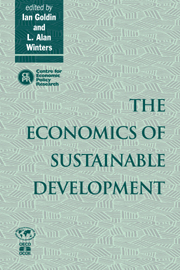Book contents
- Frontmatter
- Contents
- List of figures
- List of tables
- Preface
- Acknowledgements
- List of conference participants
- 1 Economic policies for sustainable development
- PART ONE GROWTH AND THE ENVIRONMENT
- PART TWO SUSTAINABILITY
- 4 What sustains economic development?
- Discussion
- 5 Optimal development and the idea of net national product
- Discussion
- 6 Sustainable growth and the Green Golden Rule
- Discussion
- PART THREE DOMESTIC POLICY
- PART FOUR INTERNATIONAL POLICY COORDINATION
- Index
5 - Optimal development and the idea of net national product
Published online by Cambridge University Press: 04 August 2010
- Frontmatter
- Contents
- List of figures
- List of tables
- Preface
- Acknowledgements
- List of conference participants
- 1 Economic policies for sustainable development
- PART ONE GROWTH AND THE ENVIRONMENT
- PART TWO SUSTAINABILITY
- 4 What sustains economic development?
- Discussion
- 5 Optimal development and the idea of net national product
- Discussion
- 6 Sustainable growth and the Green Golden Rule
- Discussion
- PART THREE DOMESTIC POLICY
- PART FOUR INTERNATIONAL POLICY COORDINATION
- Index
Summary
Introduction
The idea of sustainable development is associated with the Brundtland Report (World Commission, 1987). A large literature has followed in its wake. Unhappily, a good deal of it has been uninformed by an older literature that addressed a more general notion – that of optimal development. Among other things, this earlier literature drew upon modern theories of distributive justice to illuminate the nature of optimal public policies. It also was able to draw a sharper set of prescriptions even while studying a wider range of analytical models. In this chapter I shall make use of the theory of optimal development to draw conclusions about the idea of net national product (NNP) and its use for identifying optimal policies.
When anyone talks of ‘sustainable development’, it is usually in conjunction with thoughts on the management of the environment. It is therefore as well to begin with an identification of ‘environmental resources’. This will help us to see that environmental economics in large measure falls within the realm of capital theory.
For expositional ease, it will pay to ignore the any number of information, transaction, and institutional constraints that should ideally inform our discussion (on this see Dasgupta, 1993). We will be able to obtain clean formulae for NNP by this contrivance. Furthermore, I shall abstract from those kinds of nonconvexities that would make it wrong to rely exclusively on changes in NNP as a way of assessing changes in aggregate well-being (on this see Dasgupta and Maler, 1993). In the presence of significant nonconvexities, we will need more than one index. It is a matter of significance that we determine what this set should be.
- Type
- Chapter
- Information
- The Economics of Sustainable Development , pp. 111 - 143Publisher: Cambridge University PressPrint publication year: 1995
- 5
- Cited by

